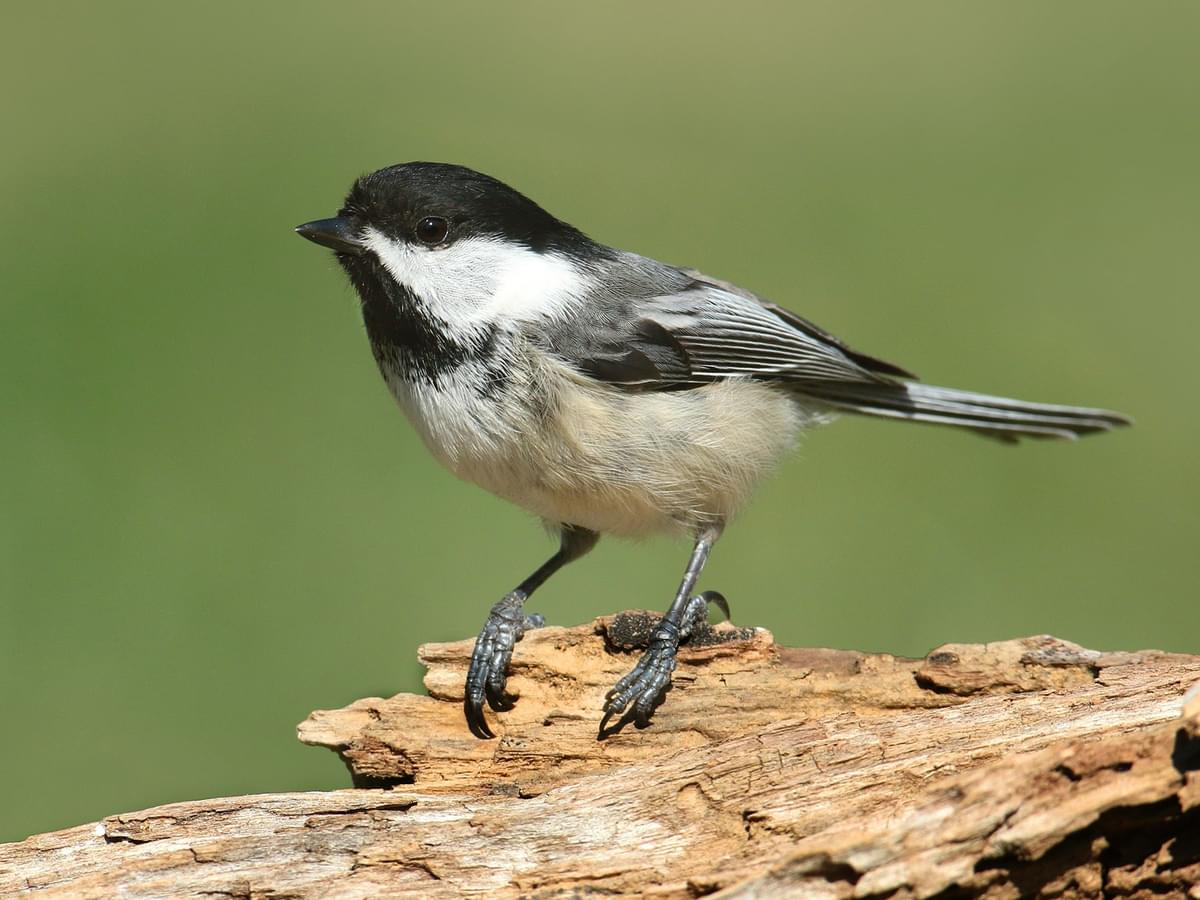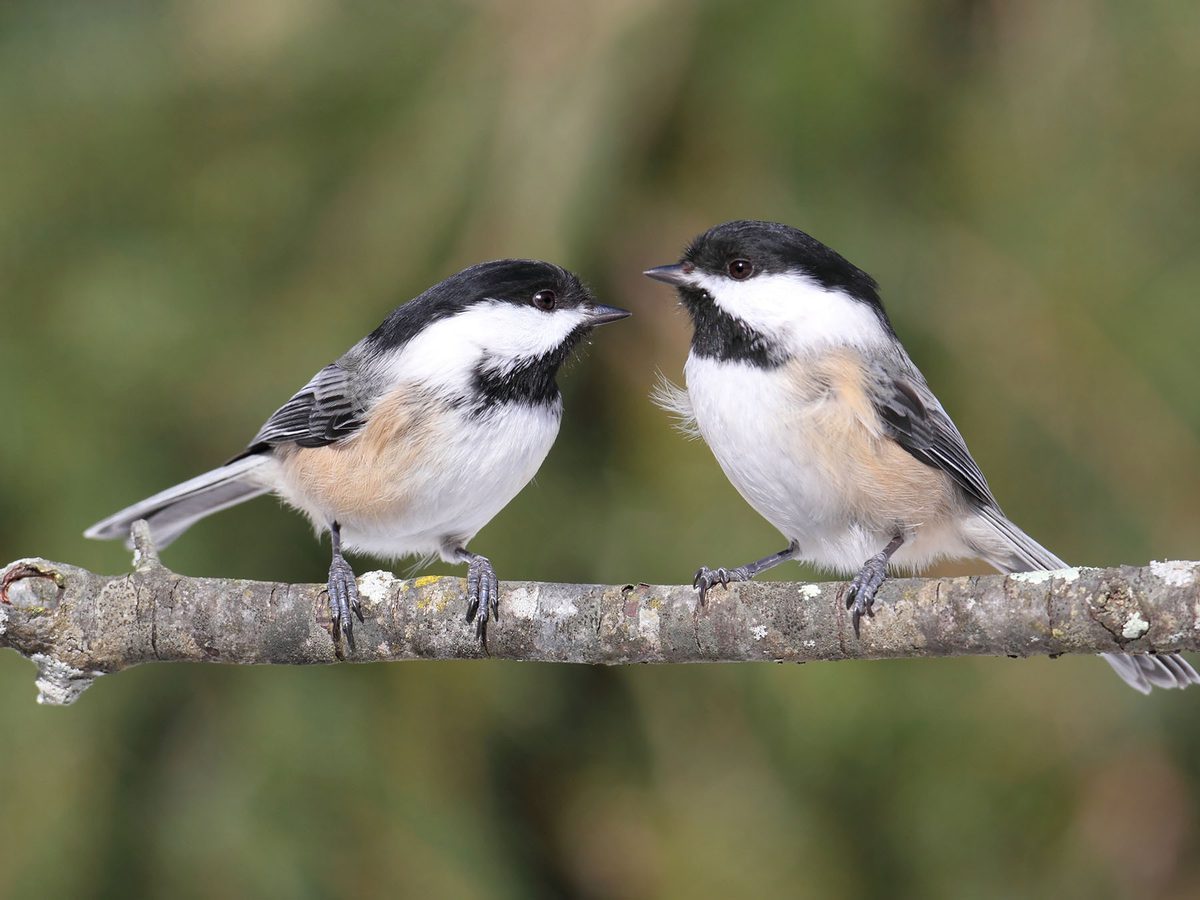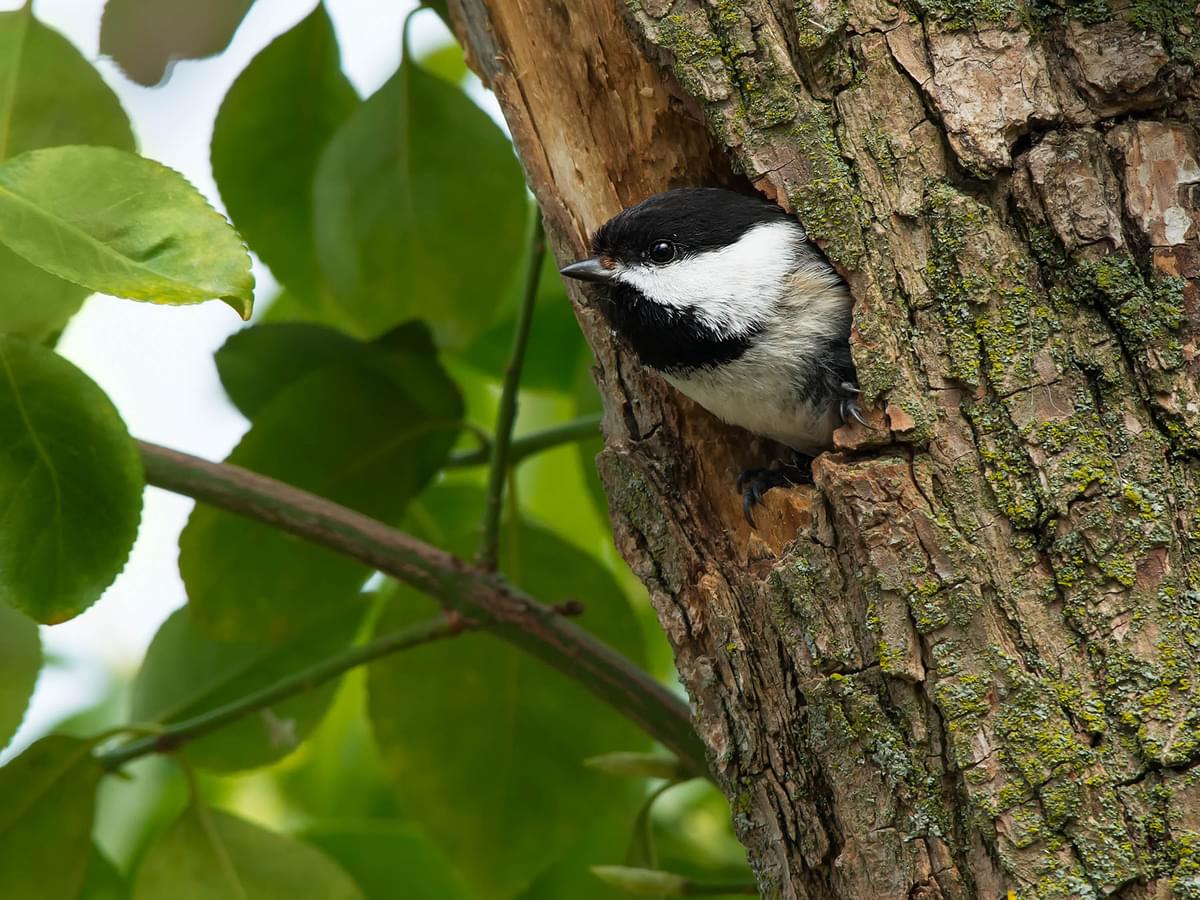Chickadees in North America (Complete Guide with Pictures)
Last updated: 14 November 2022

- Black-capped Chickadee
- Boreal Chickadee
- Carolina Chickadee
- Chestnut-backed Chickadee
- Mexican Chickadee
- Mountain Chickadee
- What are Chickadees?
- Typical Chickadee personality
- Where are the best places to see Chickadees in North America?
- What is the most common Chickadee in North America?
- What is the rarest Chickadee in North America?
- What is the largest Chickadee in North America?
- What is the smallest Chickadee in North America?
- How many types of Chickadees are there in North America?
- Are Chickadees protected in North America?
The chickadees of North America are part of the tit family genus Poecile. Chickadees are scattered throughout North America but are absent from other parts of the world.
Some chickadees are near-identical to other members of the tit family, and there are other European birds in the Poecile genus, which are called tits instead of chickadees.
There are seven species of chickadees that live throughout North America and parts of Mexico. As a genus, chickadees are very common and stretch from the East Coast to the West Coast and from Alaska and Canada to Mexico.
This is a guide to chickadees in North America.
Black-capped Chickadee
Poecile atricapillus
Length:
12cm to 15cm
Wingspan:
16cm to 21cm
Weight:
9g to 14g
Black-capped Chickadee
The Black-capped chickadee is a common chickadee that lives across much of the northern half of the United States and southern Canada, though it is found as far north as Alaska. It’s the state bird of Massachusetts and Maine and the provincial bird of New Brunswick.
This compact bird is remarkably intelligent and can memorize food caches with a high degree of accuracy, which helps them sustain its nutritional needs throughout winter. Like other chickadees, they’re excellent at surviving cold habitats and remain residents across their range through the entire year. They’re the most common Black-capped chickadees, with an estimated population exceeding 40 million.
The Black-capped chickadee has many complex vocalizations, but one of the most common is the chick-a-dee-dee-dee call which gives the genus its colloquial name. This tiny bird has been thoroughly researched, but ornithologists still haven’t reached the bottom of how it’s so tough and clever - especially given its size.
Appearance
The Black-capped chickadee is 12 to 15cm long (4.7 to 5.9in) with a wingspan of 16 to 21cm (6.3 to 8.3in). It weighs around 9 to 14g. It’s one of the larger chickadees and has the classic black cap and bib, white cheeks, gray back, and gray wings. It has boldly contrasting plumage compared to other duller chickadee species.
Boreal Chickadee
Poecile hudsonicus
Length:
12.5cm to 14cm
Wingspan:
20cm
Weight:
10g
Boreal Chickadee
The Boreal chickadee is extremely hardy. Their breeding habitat includes the boreal coniferous woodlands of Canada, Alaska, and the northernmost regions of the US. Like other chickadees, this bird is intelligent and cooperative, communicating with other birds ahead of winter to stash food for the cold months ahead.
They stay in their northern breeding range all year round and are well-adapted to the cold. They live in predominantly spruce and pine forests. The population is estimated at around 11 to 12 million.
The Boreal chickadee’s range crosses over with the Black-capped chickadee in Canada and some northern US states, and hybrids are not too uncommon.
Appearance
The Boreal chickadee has a large head, a rounded shape, and a short bill. They’re brownish gray with a brown crown and small white cheek patch, though this patch is less prominent than the Black-capped chickadee. They have cinnamon-brown flanks. Adults are 12.5 to 14.5cm (4.9 to 5.7in) long and weigh 7 to 12.4g (0.25 to 0.44oz).
Boreal Chickadee's brown crown and small white cheek patch help distinguish them from Black-capped Chickadees, which have a black cap and a more extensive white cheek patch.
Carolina Chickadee
Poecile carolinensis
Length:
10cm to 12cm
Wingspan:
15cm to 20cm
Weight:
8g to 12g
Carolina Chickadee
The Carolina chickadee is less common than the Black-capped chickadee, with whom it shares some of its range. This bird is found from New Jersey to Kansas and south to Texas and Florida. It’s highly sedentary and doesn’t tend to migrate or disperse.
In contrast to the classic chickadee song, the Carolina chickadee has a four-syllable song that goes like see-bee-see-bay. They’re exceptionally hard to tell apart from the Black-capped chickadee, but they are more discrete and shy overall, with duller plumage.
Moreover, their range only overlaps towards the west and the north and not so much in the southeast. The global population is estimated at around 12 million.
Appearance
The Carolina chickadee is very similar to the Black-capped chickadee, but it’s duller overall with less contrasting plumage.
They’re also plainer overall, though this is tough to identify unless the birds are in their fresh spring and summer plumage. They measure 11.5 to 13cm (4.5 to 5.1in) long and weigh 9 to 12g (0.32 to 0.42oz).
Chestnut-backed Chickadee
Poecile rufescens
Length:
10cm to 12cm
Wingspan:
19cm
Weight:
7g to 12g
Chestnut-backed Chickadee
The Chestnut-backed chickadee is found in the Pacific Northwest of the US and western Canada, from as far north as southern Alaska to southwestern California.
It’s a sedentary chickadee that remains in the coldest parts of its range for much of the year, though some populations move to lower elevations in the winter. Due to their small range, this is one of the less common chickadees, though the population is estimated at 12 million or so.
These sociable birds make their homes in coniferous and coastal forests. Like other chickadees, they’re incredibly well-adapted to the cold and can effectively conserve energy throughout the extremely cold winter to the north of their range.
Appearance
As the name suggests, this chickadee features a chestnut back and flank. It has a black and white on the head like other chickadees. The flank color varies across the range and is either a rich brown further north or gray further south.
Gray-headed Chickadee
Poecile cinctus
Length:
13.5cm to 14cm
Wingspan:
19cm to 21cm
Weight:
11g to 14.3g
This fascinating bird is easily the rarest chickadee and is poorly researched. It lives in the upper reaches of the Arctic, from subarctic Scandinavia and the northern reaches of the Palearctic to Alaska and the extreme northwest of Canada. The bird is known as the Siberian tit in Europe.
It almost solely occupies conifer forests and doesn't migrate, despite living in some of the harshest environments on the planet. Determined birders travel far north to see this bird which is probably relatively abundant in some cold, isolated forests.
Like many other chickadees, it’s super tough and has numerous adaptations that help it survive in the cold. There is no reliable data to estimate their population size.
Appearance
This is one of the larger chickadees, measuring 13.5 to 14cm long and weighing 11 to 14.3g. They have dark brown heads with white cheeks that aren’t actually gray, despite the name. The flanks are pale brown, but otherwise, they look similar to other chickadees.
Mexican Chickadee
Poecile sclateri
Length:
12.7cm
Wingspan:
21cm
Weight:
11.3g
Mexican Chickadee
The Mexican chickadee is somewhat of an outlier of the group, considering it lives in the relatively warm regions of Arizona, New Mexico, and western, central, and northeastern Mexico. They are considerably more common in Mexico and only exist in the furthest south of the US.
It still prefers pine forests and tends to live at higher elevations. While the bird doesn’t migrate, it does move down from high elevations during winter and cold weather.
Their song differs from other chickadees, with a burry whistle that sounds like chischu-wur. Like other chickadees, it’s social and feeds in mixed flocks with other birds. There are an estimated 500,000 to 5 million Mexican chickadees.
Appearance
One of the smaller chickadees, measuring 12.5 to 13.5cm long with a wingspan of 18 to 21cm. They weigh 7.5 to 11g. They have a black cap and white cheeks with gray flanks. Mexican chickadees look very similar to Black-capped and Mountain chickadees but have a longer black bib.
Mountain Chickadee
Poecile gambeli
Length:
13cm to 15cm
Wingspan:
19cm
Weight:
11g
Mountain Chickadee
The Mountain chickadee shares much of its range with the Boreal, Black-capped, and Chestnut-backed chickadees but is more confined to coniferous mountain regions. Their range extends south of the southern Yukon in Canada to California and the Rocky Mountains.
While they don’t migrate, they do head up and down from high and low altitudes when the weather changes in winter. There are an estimated 8 million Mountain chickadees.
Mountain chickadees have a similar chicka-dee-dee-dee call to others. They’re highly sociable and feed in mixed flocks with other species. They store food for winter and have an excellent memory of their feed caches.
Appearance
Ultimately similar to other chickadees but can be distinguished via their solid black cap that lacks the white head stripe. Almost identical in size to Black-capped chickadees but rounder overall.
What are Chickadees?
Chickadees consist of seven birds from the Poecile genus. The Poecile genus belongs to the larger Paridae family, which contains around 55 species distributed across the Americas, Europe, Africa, and some parts of Asia.
Members of the genus are called tits, and some species, like the Gray-headed tit, are distributed across the North American and European Arctic.
Most chickadees look similar - almost identical - but they diverged millions of years ago. For example, the Carolina and Black-capped chickadees are hard to tell apart but have evolved separately for 2.5 million years. However, many chickadees interbreed and hybridize, which results in some chickadees that are impossible to identify by sight alone.
These songbirds largely live in the north of the US, Canada, the Palearctic, and the Arctic. The Carolina and Mexican chickadees live further south.
Chickadees that live in the high north are excellent at caching food supplies for winter and have some half an inch of dense feathers to keep them warm. They are intelligent birds with remarkable memories and possess some very complex songs and vocalizations with thousands of variations.
Chickadees are much-loved for their friendly, social nature. They’re friendly with their own species and with others and often feed in mixed flocks alongside other songbirds.

Close up of a Black-capped Chickadee
Typical Chickadee personality
Chickadees are agile, lively, social, and generally quite bold. The Black-capped chickadee is one of the bravest chickadees and often feeds from back garden feeders or even from the hand. Other chickadees are shyer, like the Carolina chickadee.
Overall, these lively birds are curious and inquisitive and tend not to be afraid of humans.
Where are the best places to see Chickadees in North America?
There are generally more species of chickadees on the US and Canada West Coast, including the more common Black-capped chickadee and the less common Boreal, Mountain, and Chestnut-backed chickadees.
They generally prefer dense coniferous forests but can be found in various parklands and suburban areas. The Carolina chickadee is most common in the southeastern states, and the Mexican chickadee is in the far south of Arizona and New Mexico.
The only chickadee you’re very unlikely to see is the rare Gray-headed chickadee which is found in the north Palearctic and Arctic.

Dense coniferous forests are one of the best places to spot Chickadees - pictured, Carolina Chickadee
What is the most common Chickadee in North America?
The Black-capped chickadee is by far the most common chickadee in North America. Its distribution range extends throughout the upper two-thirds of the contiguous states, west to the Appalachians and south to parts of New Mexico.
In Canada, it extends from Newfoundland to British Columbia and extends northwards into the southern Yukon and Northwest Territories. The population is estimated at some 41 million.

The most common Chickadee in North American, the Black-capped Chickadee
What is the rarest Chickadee in North America?
The rarest chickadee is the Gray-headed chickadee which is only found in the furthest reaches of the Palearctic and Arctic.
Due to its highly isolated range, it’s seldom seen and is poorly researched. Nevertheless, the population is probably still large, though declining in much of Scandinavia.

The Gray-headed chickadee is the rarest Chickadee species to spot in North America
What is the largest Chickadee in North America?
The Black-capped chickadee is marginally larger than most other species, but there’s very little in it. The Gray-headed chickadee is similarly large.
What is the smallest Chickadee in North America?
The Mexican chickadee is one of the smallest and lightest chickadees. But again, there are very few tangible differences in the size and weight of chickadees.
How many types of Chickadees are there in North America?
There are seven species of chickadees that are native to North America. They are:
- Black-capped chickadee
- Mountain chickadee
- Boreal chickadee
- Carolina chickadee
- Gray-headed chickadee
- Mexican chickadee
- Chestnut-backed chickadee
Are Chickadees protected in North America?
The Migratory Bird Treaty Act (MBTA) protects most native North American birds, including birds that don’t tend to migrate, such as chickadees. Unfortunately, most chickadee populations are declining. As of 2022, none are listed as threatened on the IUCN list.
On this page
- Black-capped Chickadee
- Boreal Chickadee
- Carolina Chickadee
- Chestnut-backed Chickadee
- Mexican Chickadee
- Mountain Chickadee
- What are Chickadees?
- Typical Chickadee personality
- Where are the best places to see Chickadees in North America?
- What is the most common Chickadee in North America?
- What is the rarest Chickadee in North America?
- What is the largest Chickadee in North America?
- What is the smallest Chickadee in North America?
- How many types of Chickadees are there in North America?
- Are Chickadees protected in North America?


























